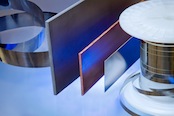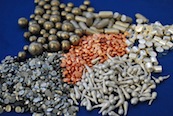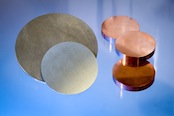Thulium Chloride
MATERIAL SAFETY DATA SHEET
I. PRODUCT IDENTIFICATION
Manufacturer/Supplier:
ESPI Metals
1050 Benson Way, Ashland, OR 97520
Toll Free (800) 638-2581 * Fax (541) 488-8313
E-Mail: This email address is being protected from spambots. You need JavaScript enabled to view it.
Product Name: Thulium Chloride
Formula: TmCl3, nH2O
CAS Number: 1331-74-4
II. HAZARDOUS INGREDIENTS
Hazardous Component: Thulium (3+) Chloride
Percent (%): 0-100
OSHA/PEL: N/E or N/A
ACGIH/TLV: N/E or N/A
Particulates Not Otherwise Regulated, Respirable Fraction: TWA: 5 mg/cu m
Particulates Not Otherwise Regulated, Total Dust: TWA: 15 mg/cu m
III. PHYSICAL DATA
Boiling Point: N/A
Melting Point: N/A
Specific Gravity: N/A
Solubility in H2O: Soluble
pH of Solution: 4.5 to 5.8 at 0 wt/wt%.
Appearance and Odor: Green crystalline solid, odorless.
IV. FIRE AND EXPLOSION HAZARDS DATA
Flash Point: N/A
Extinguishing Media: Not combustible. Use extinguishing method suitable for surrounding fire.
Special Fire Fighting Procedures: Firefighters should wear NIOSH/MSHA approved self-contained breathing apparatus and full protective clothing. Cool containers exposed to fire with water.
Unusual Fire & Explosion Hazard: Under fire conditions, toxic, corrosive fumes are emitted.
Hazardous Decomposition Materials (Under Fire Conditions): Hydrogen chloride, chlorine.
V. HEALTH HAZARD INFORMATION
Effects of Exposure:
Inhalation: Low acute inhalation toxicity. May cause upper respiratory tract irritation.
Ingestion: Harmful if ingested. May cause nausea, vomiting, diarrhea, irritation.
Skin: Skin absorption not likely. Slightly irritating. May cause redness, inflamation.
Eye: Severe irritant. Can cause redness, irritation, tissue destruction.
Medical Conditions Possibly Aggravated by Exposure: Inhalation of product may aggravate existing chronic respiratory problems such as asthma, emphysema or bronchitis.
Carcinogenic: This product does not contain any ingredient designated by IARC, NTP, ACGIH or OSHA as probable or suspected human carcinogens.
EMERGENCY AND FIRST AID PROCEDURES:
INHALATION: If respiratory irritation or distress occurs remove victim to fresh air. Seek medical attention if respiratory irritation or distress continues.
INGESTION: If victim is conscious and alert, give 2-3 glasses of water to drink and induce vomiting by touching back of throat with a finger. Do not induce vomiting or give anything by mouth to an unconscious person. Seek immediate medical attention. Do not leave victim unattended. Vomiting may occur spontaneously. To prevent aspiration of swallowed product, lay victim on side with head lower than waist. If vomiting occurs and the victim is conscious, give water to further dilute the chemical.
SKIN: In case of contact, immediately wash with plenty of soap and water for at least 5 minutes. Seek medical attention if irritation develops or persists or if visual changes occur.
EYES: Hold eyelids open and flush with a steady, gentle stream of water for at least 15 minutes. Seek medical attention if irritation develops or persists or if visual changes occur.
Notes to Physician: All treatments should be based on observed signs and symptoms of distress in the patient. Consideration should e given to the possibility that overexposure to materials other than this product may have occurred. Treat symptomatically. No specific antidote available.
VI. REACTIVITY DATA
Stability: Stable
Conditions to Avoid: Dusting conditions, open flame. Hygroscopic, protect from water/moisture.
Incompatibility (materials to avoid): Moisture, strong bases, strong acids and strong oxidizing agents.
Hazardous Decomposition Products (Thermal Decomposition): Hydrogen chloride, chlorine.
Hazardous Polymerization: Will not occur
VII. SPILL OR LEAK PROCEDURES
Steps to Be Taken in Case Material Is Released or Spilled: Wear a self-contained breathing apparatus and full protective clothing. Sweep or vacuum up and place in an appropriate closed container. Clean up residual material by washing area with water.
Waste Disposal Method: In accordance with Local, State and Federal Waste Disposal regulations.
VIII. SPECIAL PROTECTION INFORMATION
Respiratory Protection (Specify Type): Wear NIOSH/MSHA approved dust-mist-fume cartridge respirator.
Ventilation: Use local exhaust to maintain concentrations at or below PEL, TLV.
Protective Gloves: Rubber gloves
Eye Protection: Safety glasses
Other Protective Equipment: Wear protective clothing to prevent contamination of skin and clothes.
IX. SPECIAL PRECAUTIONS
Precautions to Be Taken in Handling and Storage: Avoid direct or prolonged contact with skin and eyes. Avoid breathing dusts. Dry powders can build static electricity charges when subjected to the friction of conveying, mixing or sliding. Provide adequate precautions, such as electrical grounding, or inert atmospheres when material is used in the presence of flammable materials to prevent ignition. Store in an area that is dry. Store in tightly closed containers.
Transportation Status: The listed Transportation Classification does not address regulatory variations due to changes in package size, mode of shipment or other regulatory descriptors.
US Department of Transportation Shipping Name: Not regulated.
SARA Title III Hazard: Acute Health Hazard.
National Fire Protection Association Hazard Ratings (NFPA): 3 Health Hazard Rating--Serious
National Paint & Coating Hazardous Materials Identification System (HMIS): 3 Health Hazard Rating--Serious
ESPI Believes that the information and recommendations contained herein (including data and statements) are accurate as of the date hereof. No warranty of fitness for any particular purpose, warranty of merchantability, or any other warranty, either express or implied, is made concerning the information provided herein. The information provided herein relates only to the specific product designated and may not be valid where such product issued in combination with any other materials or in any process. Further, since the conditions and methods of use of the product and of the information referred to herein are beyond the control of ESPI, ESPI expressly disclaims any and all liability as to any results obtained or arising from any use or the product or reliance on such information.
Prepared by: S Dierks
Dated: October 2002

 ALLOYS
ALLOYS 





